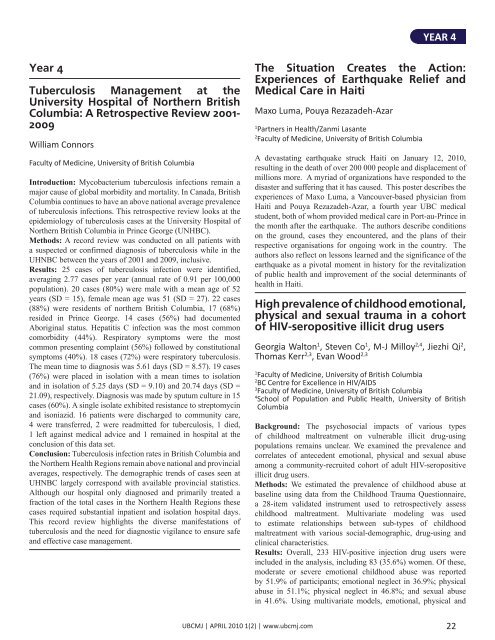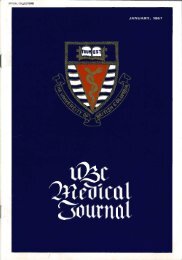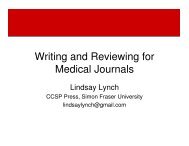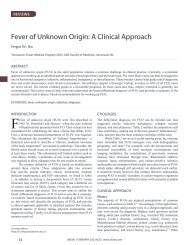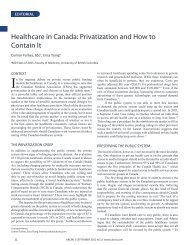Download full PDF - UBC Medical Journal
Download full PDF - UBC Medical Journal
Download full PDF - UBC Medical Journal
You also want an ePaper? Increase the reach of your titles
YUMPU automatically turns print PDFs into web optimized ePapers that Google loves.
YEAR 4<br />
Year 4<br />
Tuberculosis Management at the<br />
University Hospital of Northern British<br />
Columbia: A Retrospective Review 2001-<br />
2009<br />
William Connors<br />
Faculty of Medicine, University of British Columbia<br />
Introduction: Mycobacterium tuberculosis infections remain a<br />
major cause of global morbidity and mortality. In Canada, British<br />
Columbia continues to have an above national average prevalence<br />
of tuberculosis infections. This retrospective review looks at the<br />
epidemiology of tuberculosis cases at the University Hospital of<br />
Northern British Columbia in Prince George (UNHBC).<br />
Methods: A record review was conducted on all patients with<br />
a suspected or confirmed diagnosis of tuberculosis while in the<br />
UHNBC between the years of 2001 and 2009, inclusive.<br />
Results: 25 cases of tuberculosis infection were identified,<br />
averaging 2.77 cases per year (annual rate of 0.91 per 100,000<br />
population). 20 cases (80%) were male with a mean age of 52<br />
years (SD = 15), female mean age was 51 (SD = 27). 22 cases<br />
(88%) were residents of northern British Columbia, 17 (68%)<br />
resided in Prince George. 14 cases (56%) had documented<br />
Aboriginal status. Hepatitis C infection was the most common<br />
comorbidity (44%). Respiratory symptoms were the most<br />
common presenting complaint (56%) followed by constitutional<br />
symptoms (40%). 18 cases (72%) were respiratory tuberculosis.<br />
The mean time to diagnosis was 5.61 days (SD = 8.57). 19 cases<br />
(76%) were placed in isolation with a mean times to isolation<br />
and in isolation of 5.25 days (SD = 9.10) and 20.74 days (SD =<br />
21.09), respectively. Diagnosis was made by sputum culture in 15<br />
cases (60%). A single isolate exhibited resistance to streptomycin<br />
and isoniazid. 16 patients were discharged to community care,<br />
4 were transferred, 2 were readmitted for tuberculosis, 1 died,<br />
1 left against medical advice and 1 remained in hospital at the<br />
conclusion of this data set.<br />
Conclusion: Tuberculosis infection rates in British Columbia and<br />
the Northern Health Regions remain above national and provincial<br />
averages, respectively. The demographic trends of cases seen at<br />
UHNBC largely correspond with available provincial statistics.<br />
Although our hospital only diagnosed and primarily treated a<br />
fraction of the total cases in the Northern Health Regions these<br />
cases required substantial inpatient and isolation hospital days.<br />
This record review highlights the diverse manifestations of<br />
tuberculosis and the need for diagnostic vigilance to ensure safe<br />
and effective case management.<br />
The Situation Creates the Action:<br />
Experiences of Earthquake Relief and<br />
<strong>Medical</strong> Care in Haiti<br />
Maxo Luma, Pouya Rezazadeh-Azar<br />
1<br />
Partners in Health/Zanmi Lasante<br />
2<br />
Faculty of Medicine, University of British Columbia<br />
A devastating earthquake struck Haiti on January 12, 2010,<br />
resulting in the death of over 200 000 people and displacement of<br />
millions more. A myriad of organizations have responded to the<br />
disaster and suffering that it has caused. This poster describes the<br />
experiences of Maxo Luma, a Vancouver-based physician from<br />
Haiti and Pouya Rezazadeh-Azar, a fourth year <strong>UBC</strong> medical<br />
student, both of whom provided medical care in Port-au-Prince in<br />
the month after the earthquake. The authors describe conditions<br />
on the ground, cases they encountered, and the plans of their<br />
respective organisations for ongoing work in the country. The<br />
authors also reflect on lessons learned and the significance of the<br />
earthquake as a pivotal moment in history for the revitalization<br />
of public health and improvement of the social determinants of<br />
health in Haiti.<br />
High prevalence of childhood emotional,<br />
physical and sexual trauma in a cohort<br />
of HIV-seropositive illicit drug users<br />
Georgia Walton 1 , Steven Co 1 , M-J Milloy 2,4 , Jiezhi Qi 2 ,<br />
Thomas Kerr 2,3 , Evan Wood 2,3<br />
1<br />
Faculty of Medicine, University of British Columbia<br />
2<br />
BC Centre for Excellence in HIV/AIDS<br />
3<br />
Faculty of Medicine, University of British Columbia<br />
4<br />
School of Population and Public Health, University of British<br />
Columbia<br />
Background: The psychosocial impacts of various types<br />
of childhood maltreatment on vulnerable illicit drug-using<br />
populations remains unclear. We examined the prevalence and<br />
correlates of antecedent emotional, physical and sexual abuse<br />
among a community-recruited cohort of adult HIV-seropositive<br />
illicit drug users.<br />
Methods: We estimated the prevalence of childhood abuse at<br />
baseline using data from the Childhood Trauma Questionnaire,<br />
a 28-item validated instrument used to retrospectively assess<br />
childhood maltreatment. Multivariate modeling was used<br />
to estimate relationships between sub-types of childhood<br />
maltreatment with various social-demographic, drug-using and<br />
clinical characteristics.<br />
Results: Overall, 233 HIV-positive injection drug users were<br />
included in the analysis, including 83 (35.6%) women. Of these,<br />
moderate or severe emotional childhood abuse was reported<br />
by 51.9% of participants; emotional neglect in 36.9%; physical<br />
abuse in 51.1%; physical neglect in 46.8%; and sexual abuse<br />
in 41.6%. Using multivariate models, emotional, physical and<br />
<strong>UBC</strong>MJ | APRIL 2010 1(2) | www.ubcmj.com 22


